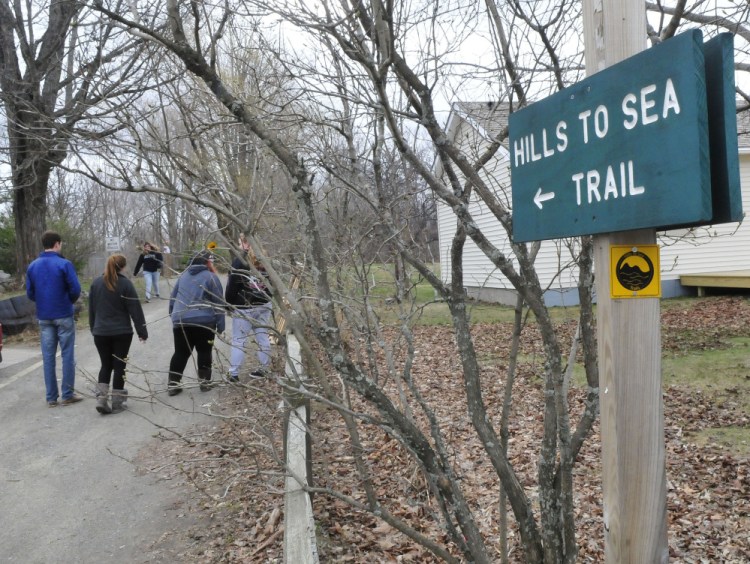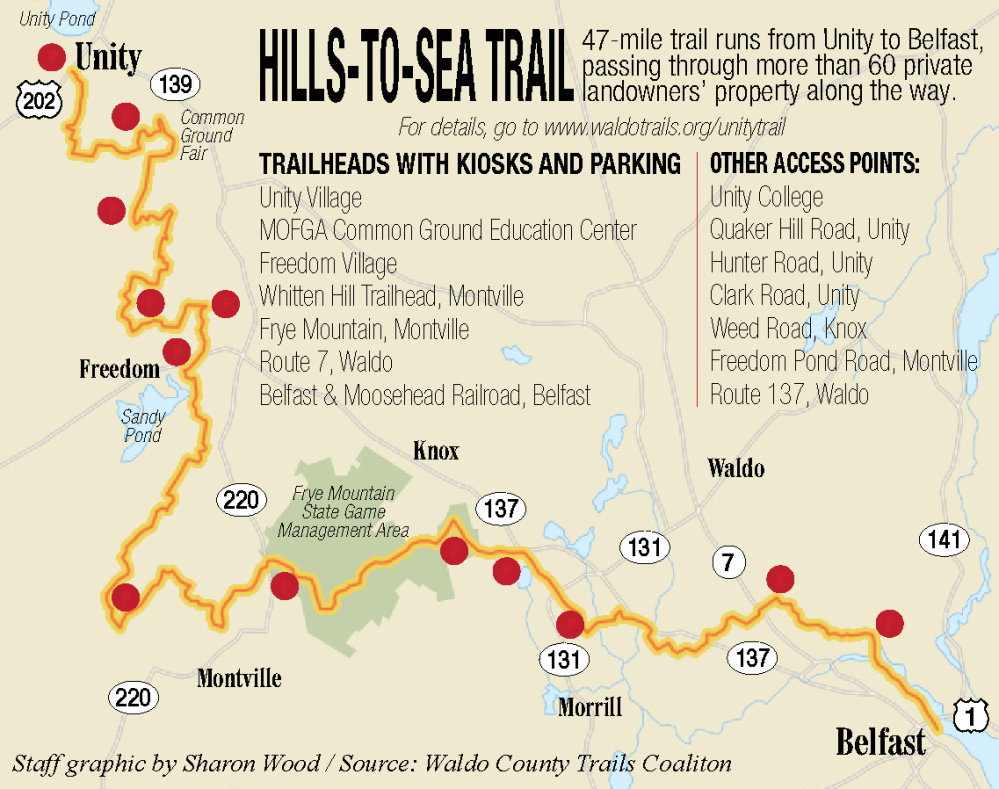UNITY — On National Trails Day, the first Saturday of June, the Waldo County Trails Coalition will hold the grand opening of a 47-mile trail connecting the central Maine to the midcoast.
The Hills-to-Sea Trail, created by volunteers, passes through 60 private properties, stretching from Unity to Belfast through the towns of Knox, Freedom, Montville and others.
The project also is scheduled to receive the Community Partnership award at the American Trails symposium, which will be held May 7 through 10 in Dayton, Ohio. American Trails is a national nonprofit that works on behalf of trail interests, providing training, resources and advocacy.
The trails coalition is made up of nine organizations in Waldo County: the Belfast Bay Watershed Coalition, Georges River Land Trust, Regional School Unit 3, Maine Farmland Trust, Maine Organic Farmers and Gardeners Association, Mid-Coast Conservancy, Sebasticook Regional Land Trust, Unity College and Unity Barn Raisers.
The Hills-to-Sea project began in 2012, when a smaller project prompted the coalition to look into the possibility of a larger system. The coalition was building a trail connecting the downtown CommUnity Trail System with the Unity College system. The group built a bridge over Sandy Stream as part of the project, and the considerable endeavor got them thinking about trails on a larger scale.
“Wouldn’t it be great to have a trail to the coast?” said Tom Mullin, an associate professor at Unity College and a member of the coalition, in an interview Thursday.
TRADITIONS AND TRENDS
A number of countries in Europe have large, connected trail systems that promote local economies and stimulate tourism. The England Coast Path, for example, will stretch around the coasts of the country and be the longest trail of its kind in the world when completed in 2020.
“The whole idea of walking as part of the daily routine is definitely instrumental in the European model of crossing over land,” Mullin said.
The Maine tradition of landowners letting strangers walk on their property echoes that European model, Mullin said, and it played a key part in the creation of the Hills-to-Sea Trail, which winds through more than 30 miles of private property.
More than 60 landowners agreed to let the project pass through their property, “all of them on handshake deals,” Mullin said at a recent presentation about the trails, held at 369 School St., the former headquarters for the Sebasticook Regional Land Trust. None of the deals include easements or land purchases — just simple agreements to let people use the land as long as they follow some guidelines.
While these partnerships are among the extraordinary elements of the project, they also put the trail in a precarious position.
“From beginning to end, (we) knew it might never happen,” said Buck O’Herin, the coalition’s stewardship coordinator. While more than 60 people said yes, the group had asked more than 150 people over the years.
To build the trail, he said, volunteers would “just go out and thrash through the woods” while looking for the “most interesting features.” However, getting landowner permission to build a trail often rerouted them, O’Herin said.
The landowners who agreed to be part of the project did so because they “believe in the idea of connecting the communities” and providing access to nature, Mullin said in an interview.
Demand for proximity to walking trails is also a growing national trend. According to a 2008 survey from the National Association of Homebuilders, 57 percent of prospective homeowners sought out nearby trails as their No. 1 amenity, surpassing others such as golf courses, security and access to shopping.
O’Herin said that, thanks to a statewide liability law, opening up private land for public use is fairly risk-free. Since the Georges River Land Trust started using handshake agreements 25 years ago, none has been revoked, he said.
The hard work begins now, since the trail was completed in the fall, Mullin said.
STEWARDSHIP
“When I learned we had finished the last section, I had this really great warm feeling in me,” Mullin said. “And then I realized, whoa, we have a lot of work to do still.”
The coalition has to develop a maintenance and stewardship program for the long term, he said, which means recruiting a lot of volunteers. Mullin said they’re optimistic about it, given how close the trails are to a lot of downtown areas, as well as the volunteer response they’ve received so far.
Other problems might arise from using private property. For example, O’Herin said the coalition found out recently a landowner had harvested trees on part of his property, slicing into the trail area and taking out the blazes and markers. Now they have to reroute the trail through another area.
“We still don’t have enough stewards to monitor all the trail sections,” he said. As they expect the large trail to garner a lot of interest, they want to make sure no cuts happen that they don’t know about.
At the same time, they have to maintain relationships with the landowners.
“What nobody’s going to realize besides us, who interact with the landowners, is how tenuous this might be depending on the different landowners,” he said, adding that they need to make sure those who use the trail are aware of the rules in place in different areas.
“Volunteers are going to be key to the life of this project,” O’Herin said.
Thanks in part to volunteer labor, the trail cost about $50,000 to complete. The coalition raised money through grants mostly, including $15,000 from the Quimby Family Foundation and $10,000 from the Davis Conservation Foundation.
It also wants to look at building out the trail, creating a series of connections like a spine moving up from the coast, Mullin said. They hope to connect with landowners, farmers or business people to encourage economic development and create more of a draw. For example, one couple put a yurt on their property and rented it out on Airbnb.com, getting visitors from as far away as Europe.
There’s also talk of extending the trails. O’Herin said he’s met with the stewards of the Kennebec Messalonskee Trails, which run through Waterville, Oakland and Winslow. The group was interested in building a trail from Waterville to Unity, he said. While it’s not in the works now, O’Herin said the coalition will look at that potential project in the future.
Madeline St. Amour — 861-9239
mstamour@centralmaine.com
Twitter: @madelinestamour
Send questions/comments to the editors.






Comments are no longer available on this story